Subaru
Forester Rear Brake Pads Replacement Guide
How to change the rear disc brake pads on
a 4th generation 2014 to 2018 Subaru Forester with the part numbers.
By Paul B. Michaels Author & Photographer Auto Mechanic Since 1989 |
||
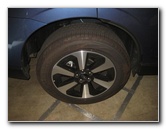 2017 Forester Rear Wheel |
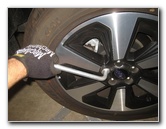 Slightly Loosen Lug Nuts |
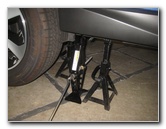 Raise Rear of SUV |
| This automotive maintenance tutorial
was specifically written to assist owners of the fourth generation
(2014, 2015, 2016, 2017 and 2018) Subaru Forester SUV in changing
the rear disc brake pads and lubricating the caliper slider pins. Owners of other Subaru vehicles such as the Outback, Impreza, Legacy, XV Crosstrek, WRX, BRZ, SVX, Tribeca, Exiga, Trezia, Levorg and Baja may also find these DIY instructions to be helpful. A few compatible replacement sets of new rear brake pads with their part numbers are as follows: Wagner ZD1114, TRW TPC1114, Subaru 26696 FJ000, ACDelco 14D1114CH, Akebono ACT1114 and Bosch BC1114. The tools and other items needed to complete this procedure include a lug nut wrench, a floor jack, two jack stands, a 14mm socket with a 3/8" drive ratchet, an "F" clamp and a tube of Sil-Glyde silicone based brake caliper grease.
Note - If your Subaru has an electronic parking brake ("EPB"), it may be preferred to use an OBDII scan tool or "OBD2 scanner" such as the official Subaru Select Monitor to put the EPB into "brake maintenance mode" before servicing. Once the EPB is in brake maintenance mode, disconnect the negative (ground) 12V battery cable. Push back the piston as usual. When you are done changing the pads, use the SSM (Subaru Select Monitor) to exit brake maintenance mode. The service manual also specifies that the Subaru Select Monitor may not be required. If the parking brake has NOT been set and is in the "Off / Retracted" mode, you can proceed as normal to gently and carefully push back the piston with an "F" clamp if you have the same standard brake pistons as shown on this page below. Disconnecting the negative 12V battery cable before proceeding is also recommended. Note - If your Forester has "screw-in" type rear caliper pistons, you will need a brake piston tool to rotate them back in the clockwise direction to retract the pistons.. Please refer to my Subaru Outback Rear Brake Pads Replacement Guide for info on that procedure. |
||
|
|
||
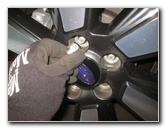 Spin Off Lug Nuts |
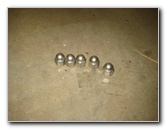 Five Lug Nuts Removed |
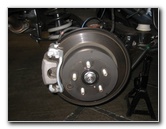 Caliper, Bracket & Rotor |
| The first few steps
are to park the SUV on a level surface, turn off the ignition and place the
transmission in park. Make sure that the emergency / parking brake is not engaged. (If the parking brake isn't released, you won't be able to pull the rear brake caliper off the old pads and out of the bracket.) Place wheel chocks on both sides of the front tires to prevent the vehicle from moving. I prefer to work on one side of the vehicle at a time to keep three tires on the ground for extra safety. Slightly loosen the five lug nuts on the rear wheel by turning them about 1/4 turn in the counterclockwise direction with the tire iron. Raise the rear of the car with the floor jack and securely support it with at least two jack stands. (The jack point is marked on the pinch weld by a triangle.) Spin off the five lug nuts and set them aside in a safe place. Pull off the rear wheel to reveal the caliper, bracket, rotor and suspension. |
||
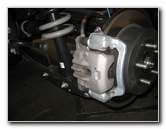 Rear Brake Caliper |
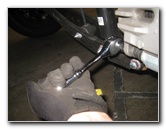 Loosen Lower Caliper Bolt |
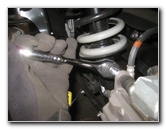 Loosen Upper Caliper Bolt |
| The rear brake
caliper is held in place to the bracket by two bolts located on the back
side of the caliper with the bolt heads facing in towards the center of the
SUV. Loosen the two caliper bolts by turning them in the clockwise direction (as seen from the outside of the vehicle) with the 14mm socket and a 3/8" drive ratchet. |
||
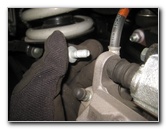 Spin Out Top Bolt |
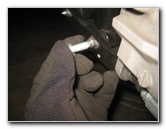 Spin Out Bottom Bolt |
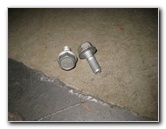 Two Bolts Removed |
| Spin out the two caliper bolts and set them aside in a safe place. | ||
 Lift Caliper Off Pads |
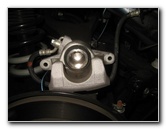 Rest Caliper On Rotor |
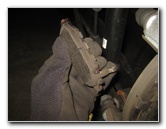 Wear Bar - Bottom Inner Pad |
|
Carefully lift the caliper out of the bracket
and off the old brake pads. Rest the caliper on the rotor or suspend it from the suspension spring with a bungee cord or some twine. Try to avoid bending, kinking or stressing the rubber brake fluid hose. Pull the old inner brake pad out of the bracket. You'll notice that there is a wear indicator bar or "squeal" bar situated at the bottom of the inner pad. |
||
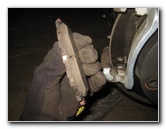 Remove Old Outer Pad |
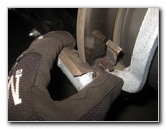 Replace Pad Abutment Clips |
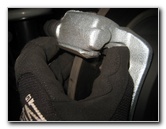 Top Abutment Clip |
| Pull the old outer
brake pad out of the bracket. If your new set of rear brake pads includes replacement hardware, pull the old pad abutment clips (or "anti-rattle" clips) out of the top and bottom of the bracket. Apply a thin layer of brake caliper grease to the parts of the new pad abutment clips that will come in contact with the bracket and the "ears" of the new brake pads. You can also apply some lubricant grease to the parts of the bracket that will come in contact with the abutment clips. Update - If your Subaru is equipped with the "screw-in" type rear caliper pistons with the EPB (electronic parking brake) do NOT apply lubricant to the caliper piston. Here is the information from the service manual - "As the [rear caliper] piston moves towards the inner brake pad, the serrations machined into the outer face of the piston bite into the inner brake pad shim (permanently mounted to the brake pad) to prevent the piston from rotating when mechanical force begins to increase. Do not lubricate or apply any anti-seize paste to this area." If your Subaru has the standard "push in" caliper piston like this 2017 Forester, feel free to lubricate the outer ring of the caliper piston. Push the new pad abutment clips into the top and bottom of the bracket until they are fully seated. |
||
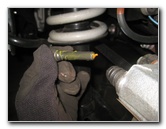 Pull Out Caliper Slider Pins |
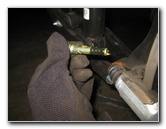 Lubricate & Replace Pins |
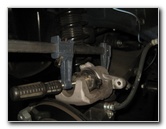 Attach "F" Clamp To Caliper |
|
In order for the brake caliper to operate smoothly, the two caliper slider pins or "guide bolts" need to be well lubricated. Pull the two caliper slider pins out of their rubber dust boots. Apply a thin layer of silicone based brake parts lubricant grease to the smooth parts of the two caliper slider pins. The preferred rubber safe silicone lubricant for the caliper slider pins is Sil-Glyde. (Do not use petroleum based brake grease since it can cause the rubber parts such as the bushing or "sleeve" on the caliper slider pin or the rubber dust boot to swell which can lead to braking problems such as a seized or "frozen" caliper slider pin.) Push the caliper slider pins back into their rubber dust boots within the bracket.
Attention: If your Forester is equipped with an electronic parking brake or "EPB" here is the Subaru service manual procedure for replacing the rear brake pads if you do NOT have the Subaru Select Monitor (SSM) computer device to enable "Parking Brake Maintenance Mode". "1. Release the parking brake. After the operation is completed, apply and release the parking brake five times and ensure that the brake operates normally." Paul's Notes - In the service manual picture it looks like they are using a standard "F" clamp to push back the piston. I omitted the steps that involved the SSM (Subaru Select Monitor). Basically, as long as the electric parking brake is OFF and you disconnect the negative "-" terminal on the 12V car battery, you should have no problem pushing back the rear caliper piston. If you encounter any resistance, do not force in the piston. Consult with your dealership or a qualified automotive technician. In order for the caliper to fit over the thicker new brake pads, the caliper piston need to be compressed or "retracted" back into the caliper assembly. Attach the "F" clamp to the caliper and use the back of an old brake pad to evenly distribute the pressure across the piston. |
||
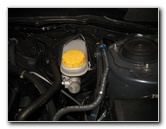 Brake Fluid Reservoir |
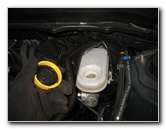 Twist Off Reservoir Cap |
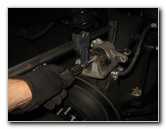 Compress Caliper Piston |
| Move to the right
rear area of the engine bay and locate the brake fluid reservoir which has a yellow plastic cap on top. Twist off the brake fluid reservoir cap in the counterclockwise direction and set it aside in a safe place. Slowly turn the "F" clamp handle in the clockwise direction to push back the caliper piston until it is flush with the rubber dust boot that surrounds it. If you have trouble compressing the caliper pistons, stop, and double check that the EPB (electronic parking brake) has been released. If you are still unable to compress them, you may need to purchase a scan tool capable of placing the EPB into brake maintenance mode or visit a dealership for service. Try to avoid pinching or damaging the rubber dust boot that surrounds the piston. Once the piston is fully compressed, detach the "F" clamp and discard the old brake pad. |
||
|
|
||
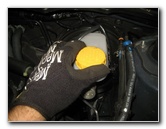 Replace Brake Fluid Cap |
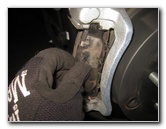 Install New Outer Pad |
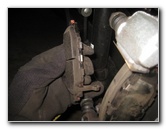 Wear Bar - Bottom Inner Pad |
| Replace the
reservoir cap as soon as possible since brake fluid hygroscopic (absorbs
moisture from the air). Thoroughly clean off the brake rotor, caliper bracket, brake caliper assembly and the lug studs with brake parts cleaner spray. Do not use compressed air or blow with your mouth to clean off the brake parts. Inhaling brake dust can be harmful to your health since brake dust can be carcinogenic (cancer causing) if inhaled. Apply a thin layer of brake parts lubricant grease to any area where there is metal to metal contact such as the outer lip of the caliper piston, the pad abutment clips and the ends or "ears" of the new pad. Do not apply brake caliper grease to the friction surface of the new pads or the rotor!
To remove the existing rotors and install new ones, remove the two 14mm bolts on the rear of the caliper bracket that attach it to the steering knuckle. Then loosen the old rotor with a rubber mallet, pull it off, and slide the new one in its place. The 14mm rear brake caliper bracket bolts torque specification is 48.7 lb-ft. I recommend installing the Wagner ZD1114 QuickStop brake pads since they have excellent reviews on Amazon. Orientate the wear indicator bar at the bottom of the inner brake pad. Install the two new brake pads into the bracket. |
||
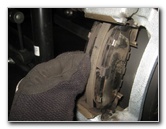 Install New Outer Pad |
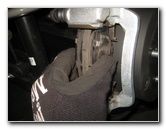 Push Pads Against Rotor |
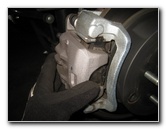 Lower Caliper Over Pads |
| Push the two pads
together until they are flush against the rotor. Carefully lower the caliper over the new pads and into the bracket. |
||
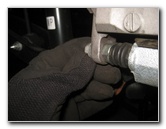 Spin In Lower Bolt |
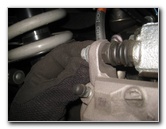 Replace Upper Bolt |
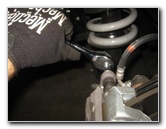 Tighten Top Bolt |
| Line up the bolt
holes in the caliper with their corresponding holes in the caliper slider
pins within the bracket. Spin in the two caliper bolts a few turns by hand in the counterclockwise direction (as seen from the outside of the SUV) to prevent them from becoming cross threaded. |
||
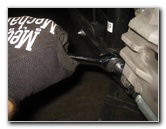 Tighten Bottom Bolt |
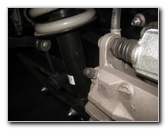 Rubber Valve Cap |
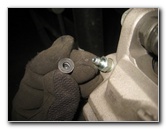 Brake Fluid Bleeder Valve |
| Tighten the two
caliper bolts by turning them in the counterclockwise direction (as seen
from the outside of the car) with the 14mm socket and a 3/8" drive ratchet
to just past hand tight or about 20 lb-ft of torque. Double check that the two caliper bolts are tight before moving on to the next steps. (The service manual specifies the rear brake torque values as follows: caliper 19.9 lb-ft, bracket, 48.7 lb-ft and bleeder valve 5.9 lb-ft.) If your Forester's brake pedal has been feeling soft or spongy, the brake fluid may be contaminated with water or the brake lines may contain some air bubbles. It would be best to bleed the brake lines at this time in order to flush out the old fluid and replace it with new DOT 3 brake fluid. For more on this topic, please take a look at my Brake Line Fluid Bleeding With An Assistant DIY Guide or there is also my Brake Line Fluid Bleeding With A Power Bleeder Guide. The brake fluid bleeder valve is located underneath a rubber cap on the back side of the caliper just below the top caliper bolt. |
||
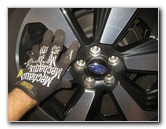 Replace Rear Wheel |
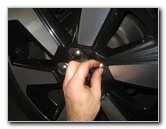 Spin On Five Lug Nuts |
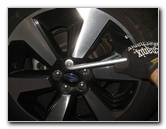 Slightly Tighten Lug Nuts |
| Carefully push
the rear wheel over the lug studs. Spin on the five lug nuts a few turns by hand in the clockwise direction to prevent them from becoming cross threaded. Slightly tighten the lug nuts in a "criss cross" or "star" pattern with the lug nut wrench. |
||
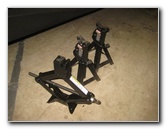 Lower Car From Stands |
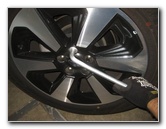 Torque 88 To 110 lb-ft |
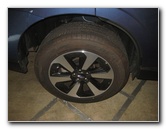 Rear Brake Pads Replaced |
| Carefully lower the
car from the jack stands by using the floor jack. Continue progressively tightening the lug nuts in a star or criss cross pattern to about 1/4 turn past hand tight. It would be best to use a torque wrench or an electric impact wrench with a torque stick to properly tighten the lug nuts. The owner's manual lists the lug nut torque specification as being a range between 88 lb-ft to 110 lb-ft. (If you disconnected the 12V battery, re-attach the negative cable.) Sit in the driver's seat of the vehicle and firmly push down the brake pedal a few times to restore the brake line pressure. Check the brake fluid in the reservoir and verify that it is at the proper level. If it is low, pour in some fresh DOT 3 brake fluid from a new bottle. To break in your new rear brake pads, just try to drive normally for the first few hundred miles while avoiding any hard or "panic" stops which may glaze over the new pads and cause them to become noisy and not perform as well. It's also a good idea to regularly check your driveway, garage or parking spot for drops of fresh brake fluid which may indicate a leak, check the brake fluid level in the reservoir and also verify that the lug nuts are still tight. If your SUV has an EPB (electronic parking brake), the service manual recommends that you engage and disengage the EPB parking brake several times to make sure it is working properly. Be sure to record the rear brake pad change in your SUV's service records. For more,
please check out all of my
2014-2018 Subaru Forester DIY Repair & Maintenance Guides. |
||
| If you found this guide to be helpful,
please consider making a small donation by clicking on the PayPal.com
"Donate" button located to the right of this paragraph. Thank you!
(Note: I am not a registered charity. Donations are not tax deductible.) |

